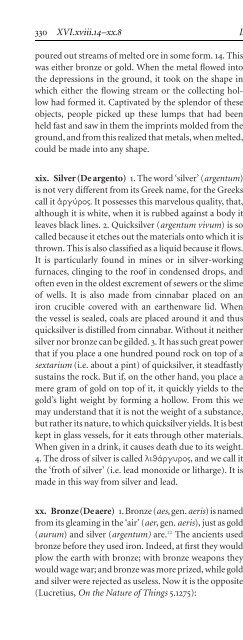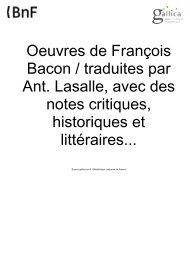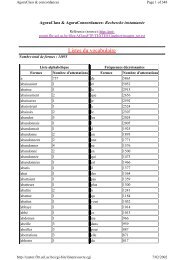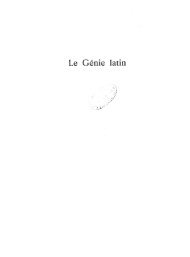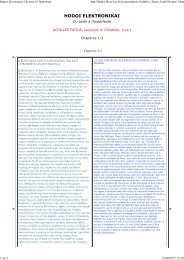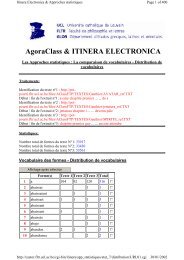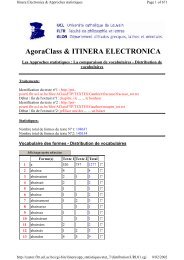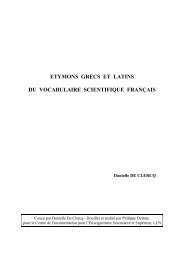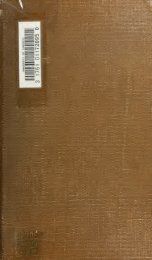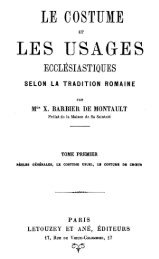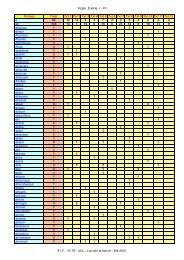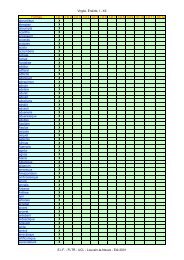The Etymologies of Isidore of Seville - Pot-pourri
The Etymologies of Isidore of Seville - Pot-pourri
The Etymologies of Isidore of Seville - Pot-pourri
Create successful ePaper yourself
Turn your PDF publications into a flip-book with our unique Google optimized e-Paper software.
330 XVI.xviii.14–xx.8 <strong>Isidore</strong> <strong>of</strong> <strong>Seville</strong><br />
poured out streams <strong>of</strong> melted ore in some form. 14.This<br />
was either bronze or gold. When the metal flowed into<br />
the depressions in the ground, it took on the shape in<br />
which either the flowing stream or the collecting hollow<br />
had formed it. Captivated by the splendor <strong>of</strong> these<br />
objects, people picked up these lumps that had been<br />
held fast and saw in them the imprints molded from the<br />
ground, and from this realized that metals, when melted,<br />
could be made into any shape.<br />
xix. Silver (De argento) 1.<strong>The</strong>word‘silver’ (argentum)<br />
is not very different from its Greek name, for the Greeks<br />
call it .Itpossesses this marvelous quality, that,<br />
although it is white, when it is rubbed against a body it<br />
leaves black lines. 2. Quicksilver (argentum vivum) isso<br />
called because it etches out the materials onto which it is<br />
thrown. This is also classified as a liquid because it flows.<br />
It is particularly found in mines or in silver-working<br />
furnaces, clinging to the ro<strong>of</strong> in condensed drops, and<br />
<strong>of</strong>ten even in the oldest excrement <strong>of</strong> sewers or the slime<br />
<strong>of</strong> wells. It is also made from cinnabar placed on an<br />
iron crucible covered with an earthenware lid. When<br />
the vessel is sealed, coals are placed around it and thus<br />
quicksilver is distilled from cinnabar. Without it neither<br />
silver nor bronze can be gilded. 3.Ithassuchgreat power<br />
that if you place a one hundred pound rock on top <strong>of</strong> a<br />
sextarium (i.e. about a pint) <strong>of</strong> quicksilver, it steadfastly<br />
sustains the rock. But if, on the other hand, you place a<br />
mere gram <strong>of</strong> gold on top <strong>of</strong> it, it quickly yields to the<br />
gold’s light weight by forming a hollow. From this we<br />
may understand that it is not the weight <strong>of</strong> a substance,<br />
but rather its nature, to which quicksilver yields. It is best<br />
kept in glass vessels, for it eats through other materials.<br />
When given in a drink, it causes death due to its weight.<br />
4.<strong>The</strong>dross <strong>of</strong> silver is called ,andwecallit<br />
the ‘froth <strong>of</strong> silver’ (i.e. lead monoxide or litharge). It is<br />
made in this way from silver and lead.<br />
xx. Bronze(Deaere) 1.Bronze(aes,gen.aeris)isnamed<br />
from its gleaming in the ‘air’ (aer,gen.aeris), just as gold<br />
(aurum) andsilver (argentum) are. 12 <strong>The</strong> ancients used<br />
bronze before they used iron. Indeed, at first they would<br />
plow the earth with bronze; with bronze weapons they<br />
would wage war; and bronze was more prized, while gold<br />
and silver were rejected as useless. Now it is the opposite<br />
(Lucretius, On the Nature <strong>of</strong> Things 5.1275):<br />
Bronze is despised and gold has attained the highest<br />
honor: thus time in its turning changes the positions <strong>of</strong><br />
things, and what was prized becomes finally without<br />
value.<br />
<strong>The</strong> use <strong>of</strong> bronze later spread to statues, vessels, and the<br />
construction <strong>of</strong> buildings. Public proclamations in particular<br />
were written on bronze plaques for a permanent<br />
record.<br />
2.Cyprian bronze (i.e. copper) was first found on the<br />
island <strong>of</strong> Cyprus, whence it was named. It is made from<br />
abronze-like stone that they call cadmia, and it is malleable.<br />
If lead is added to it, it turns purple. 3. Aurichalcum<br />
is so called because it possesses the splendor <strong>of</strong> gold<br />
(aurum) and the hardness <strong>of</strong> bronze. Its name is composed<br />
from both the Latin and Greek languages, for the<br />
Greeks call bronze . Moreoveritismadefrom<br />
bronze and a great deal <strong>of</strong> fire, and it is brought to a<br />
gold color by means <strong>of</strong> additives. 4. Corinthian bronze<br />
is a mixture <strong>of</strong> all metals, which was first mixed accidentally<br />
when Corinth was burned after being captured.<br />
When Hannibal had captured this city, he gathered all<br />
the bronze and gold and silver statues into a single pyre<br />
and burned them. Workmen carried this mixture <strong>of</strong>f and<br />
made plates. Thus Corinthian vessels were created from<br />
all the metals (i.e. gold, silver, and bronze) combined to<br />
make a single alloy that was neither one particular metal<br />
nor another. Hence even up to the present day things<br />
made either <strong>of</strong> this substance or <strong>of</strong> an imitation <strong>of</strong> it<br />
are called ‘Corinthian bronze’ or ‘Corinthian vessels.”<br />
<strong>The</strong>re are three kinds: the first is white and approaches<br />
the luster <strong>of</strong> silver; the second has by nature the yellow<br />
<strong>of</strong> gold itself; the third has an equal mixture <strong>of</strong> all.<br />
5. Coronarium is drawn out from malleable bronze<br />
into sheets. Tinted by the bile <strong>of</strong> bulls, it looks like gold<br />
in the garlands (corona) <strong>of</strong>stage-actors, whence it is<br />
named. 6. Pyropus is named from its fiery color (cf. ,<br />
“fire”). When six grams <strong>of</strong> gold are added to each ounce<br />
<strong>of</strong> bronze, the thin metal leaf becomes fiery and gives an<br />
imitation <strong>of</strong> flame; for this reason also it is called pyropus.<br />
7.Bronze that is called regularis (lit. “in ingots”) is called<br />
‘ductile’ (ductilis)byotherpeople–allCyprianbronzeis<br />
<strong>of</strong> this kind. 8.Bronze that is drawn out with a hammer<br />
is called ‘ductile’ (ductilis) just as, on the other hand,<br />
bronze that can only be poured out (fundere,ppl. fusus)<br />
12 <strong>The</strong> word aes means either “bronze” or “copper.”


